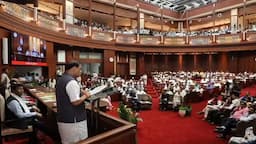US President Donald Trump declared that his administration’s newly imposed 50% tariffs on Indian imports covering both reciprocal duties and penalties linked to India’s purchase of Russian oil have dealt a “big blow” to Moscow’s economy.
He made these remarks during a press briefing at the White House ahead of his planned summit with Russian President Vladimir Putin in Alaska.

The tariffs were rolled out in two stages: an initial 25% reciprocal tariff announced on July 30, followed by an additional 25% surcharge on India’s continued purchase of Russian oil bringing the total to 50%.
Trump painted India as Russia’s “largest or second-largest oil buyer,” asserting that the punitive duties had significantly battered Russia’s financial stability.
Indian authorities swiftly labeled the measures "unfair, unjustified and unreasonable," emphasizing that market dynamics — not geopolitics — shape their oil procurement strategy. They also rejected any portrayal of India as supporting Russian aggression.
On the global stage, US Senator Lindsey Graham echoed Trump’s hardline stance, branding the tariff as a “game changer” and warning that other nations especially those involved in funneling Russian crude were under scrutiny.
Domestically, the Indian public responded sharply. Calls to boycott US brands such as McDonald’s and Apple surged across social media, while business leaders renewed their focus on economic self-reliance and bolstering indigenous manufacturing.
Paradoxically, Indian stock markets displayed remarkable resilience. The Nifty50 and BSE Sensex indices remained steady, signaling investor confidence in India’s economic fundamentals and expectations of future de-escalation.

This tariff escalation broadens the US–India trade tensions significantly. Just months earlier, PM Narendra Modi visited Washington and struck a 10-year framework aimed at boosting bilateral trade to $500 billion by 2030. Trump’s latest moves have complicated that objective.
The policy shift also reflects broader US efforts to isolate Russia economically. A recent Senate majority supported secondary sanctions that could impose tariffs up to 500% on countries that continue buying Russian energy placing India and China squarely in the crosshairs.
With the Trump–Putin summit in Alaska set for Aug 15, the trade friction adds diplomatic volatility. Trump suggested he is open to brokering peace in Ukraine, positioning India’s tariff move as part of a broader strategic posture.












